In an age of escalating climate concerns and dwindling fossil fuel reserves, Building-Integrated Photovoltaics (BIPV) emerges as a beacon of sustainability. It transcends the traditional solar energy paradigm by amalgamating the generation of renewable energy with the architectural design of buildings. The system seamlessly fuses with the structure, not just as an additional layer but as an integral component of the building itself. The intrinsic blend of utility and design makes BIPV a cornerstone in the edifice of tomorrow’s sustainable architecture.
Why It Matters: Beyond Aesthetics and Functionality
BIPV is not just another technological advance but an imperative step in the journey toward sustainable urban environments. While the aesthetic aspects are undeniably attractive, the system’s core brilliance lies in its functional aspects. Think of a skyscraper in the heart of a bustling city, where every window pane contributes to electricity generation. BIPV integrates solar cells into building materials, ensuring each structure becomes an individual power plant, contributing to a decentralized energy grid. This self-sufficiency lowers the dependency on external energy sources, reducing the overall carbon footprint.
Types: More than Just Solar Panels
When you delve into BIPV, you will encounter three primary types:
- BIPV Windows: Transparent solar panels that replace conventional glass windows.
- BIPV Facades: Exterior walls fitted with photovoltaic materials to capture solar energy.
- BIPV Roof Systems: Roofing materials embedded with solar cells, replacing the need for separate installations.
Each of these variants offers a unique approach to capturing solar energy, allowing for customization based on architectural needs and aesthetic preferences.
Compared to Traditional Solar Panels: The Distinctive Edge
Unlike traditional solar panels, BIPV systems are integral to a building’s architecture. They are not add-ons; they are built-in solutions. The integration offers multiple benefits, including structural robustness, space efficiency, and architectural flexibility. The aesthetic harmony achieved through BIPV eliminates the eyesore often associated with bolt-on solar panels, making it a viable option for urban landscapes where aesthetics and space are at a premium.
Investing: The Financial Equation
While the upfront costs of BIPV may appear steep, the long-term financial gains cannot be overlooked. Energy savings, government incentives, and the potential for selling excess power back to the grid make it a fiscally prudent investment. Over time, the system pays for itself while continuously contributing to sustainability.
Challenges and Solutions: Navigating the Landscape
Like any revolutionary technology, BIPV faces its challenges—primarily cost and efficiency. However, advancements in nanotechnology and material science are continuously boosting the efficiency rates of photovoltaic cells, making it an increasingly viable option. Government incentives and rebates further ease the initial financial burden, accelerating the global adoption of this groundbreaking technology.

Facade Solar Panels
The Future of BIPV: What Lies Ahead
We are at the cusp of an architectural renaissance powered by BIPV technology. With increased research and a growing focus on sustainable living, It is poised to become ubiquitous. We are likely to see more residential and commercial buildings adopt this integrated approach to renewable energy generation, thereby fundamentally altering the energy equation for future generations.
















